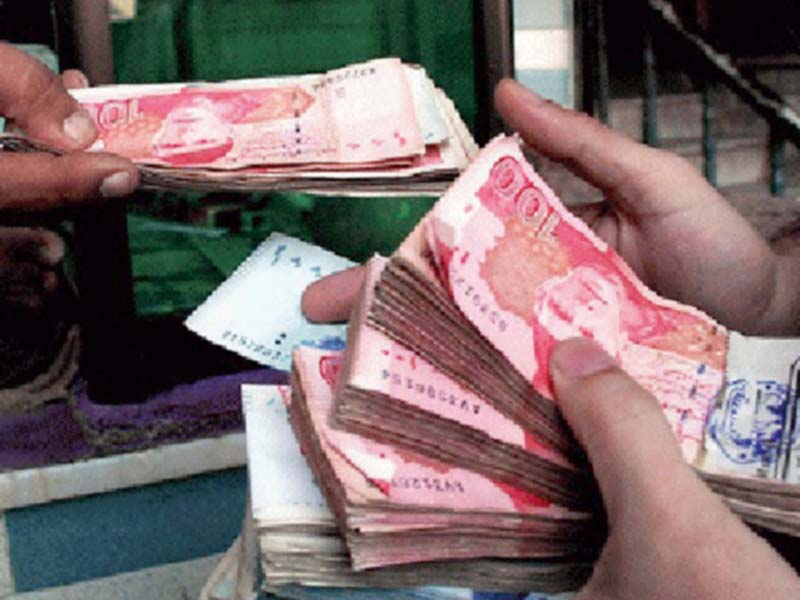
The federal budget deficit jumped to Rs894 billion or 2% of the size of national economy in the first four months of current fiscal year due to double-digit growth in expenditures despite a squeeze on both defence and development spending.
The budget deficit of 2% of gross domestic product (GDP) during the July-October period of current fiscal year was about 17% higher than the same period of last fiscal year, according to sources in the Ministry of Finance.
But it was still lower than the one recorded during the July-October period of the first year of current government.
A sluggish growth rate of hardly 4.6% in tax collection by the Federal Board of Revenue (FBR) and negative growth of 5.5% in non-tax revenue because of shrinking profit of the central bank marred the fiscal performance of Pakistan Tehreek-e-Insaf (PTI) government, said the sources. The sluggish increase in revenue, coupled with higher interest payments, is undermining efforts of the Ministry of Finance to ensure fiscal discipline.
The federal budget deficit - the gap between expenditure and revenue - remained at Rs894 billion or 2% of GDP, according to the finance ministry sources. It was higher by Rs126 billion or 17% compared with the same period of last year.
For the current fiscal year, the federal budget deficit target has been set at Rs3.43 trillion or 7.5% of GDP.
In order to bridge the gap, the government took Rs753 billion worth of loans from domestic and foreign sources. Last month, Adviser to Prime Minister on Finance Dr Abdul Hafeez Shaikh said the stock of total debt of the federal government had remained unchanged at Rs36.4 trillion during the July-October period of current fiscal year.
However, provisional numbers indicate that there can be increase in public debt, although the position will be clear once the central bank releases four-month public debt figures by the middle of current month.
Shaikh seems to be encircled by trouble. The National Accountability Bureau (NAB) has sent him a “call-up notice under Section 19 of NAO” in an investigation against officers of the FBR and others in the Agility case of “illegal payments of $11.25 million” on account of access fee.
However, a statement issued by the Ministry of Finance stated that Shaikh had not received any notice but stood ready to cooperate with NAB “according to the law in any matter”.
According to media reports, the Islamabad High Court (IHC) on Monday barred Shaikh from chairing a cabinet committee in a petition filed by the Pakistan Muslim League-Nawaz (PML-N) against Shaikh being chairman of the Cabinet Committee on Privatisation. If the government does not get relief from the court in this case, it will adversely affect the position of the finance adviser.
Both defence and development spending was lower in the first four months of current fiscal year as compared to the same period of last year, according to the sources.
Cumulative spending of Rs1.235 trillion on debt servicing and defence needs in the four months was equal to 92.2% of total taxes collected by the FBR in the July-October period. The FBR pooled Rs1.339 trillion in four months.
The development spending remained nearly 6% less in July-October of current fiscal year compared to the same period of last year. Under the Public Sector Development Programme (PSDP), the sources said, provisional development spending remained at just Rs128 billion, 5.9% or Rs8 billion less than the same period of last fiscal year.
From July through October, the federal government spent Rs931 billion on debt servicing, which was higher by Rs237 billion or 34% over the same period of previous year, said the sources. Defence spending stood at Rs304 billion in the first four months, down 5.6% or Rs30 billion.
After making payments for debt servicing and defence-related obligations, the net federal revenue for the July-October period was negative Rs209 billion, according to the sources.
The FBR pooled Rs1.339 trillion in the first four months. The debt servicing was equal to 69% of the FBR’s revenue and defence spending was equal to 22.7% of the revenue.
Net federal receipts are calculated after excluding the share of four provinces in the gross federal receipts. Gross federal receipts stood at Rs1.77 trillion, which increased only 2% or Rs35 billion over the same period of previous year.
The share of provinces in federal collection also went down by Rs69 billion or 8.5% to Rs742 billion despite a 4.6% increase in the FBR’s tax collection. The four provinces get 57.5% of federal taxes as their share under the National Finance Commission (NFC) award.
The government’s non-tax revenue dropped 5.5% to Rs429 billion despite an increase in the petroleum levy collection.
After paying Rs742 billion to the provinces, the net federal revenue amounted to Rs1.03 trillion, which was higher by Rs103 billion than the same period of last fiscal year owing to the higher petroleum levy collection. Total federal expenditures stood at Rs1.92 trillion, which were higher by Rs229 billion or 13.5% over the same period of last fiscal year. There was an increase of 15.2% in current expenditures in four months, which stood at Rs1.8 trillion.
Overall, the budget deficit, calculated after taking into account the provincial cash surplus, stood at Rs753 billion or 1.7% of GDP. It was 0.4-percentage-point higher than the same period of last fiscal year.
The primary balance, being calculated after excluding interest payments, stood at Rs178 billion or 0.4% of GDP. It was better than the previous fiscal year.
Published in The Express Tribune, December 8th, 2020.
Like Business on Facebook, follow @TribuneBiz on Twitter to stay informed and join in the conversation.


















COMMENTS
Comments are moderated and generally will be posted if they are on-topic and not abusive.
For more information, please see our Comments FAQ